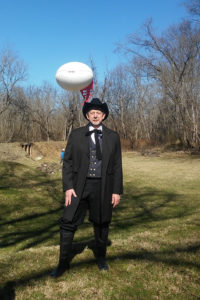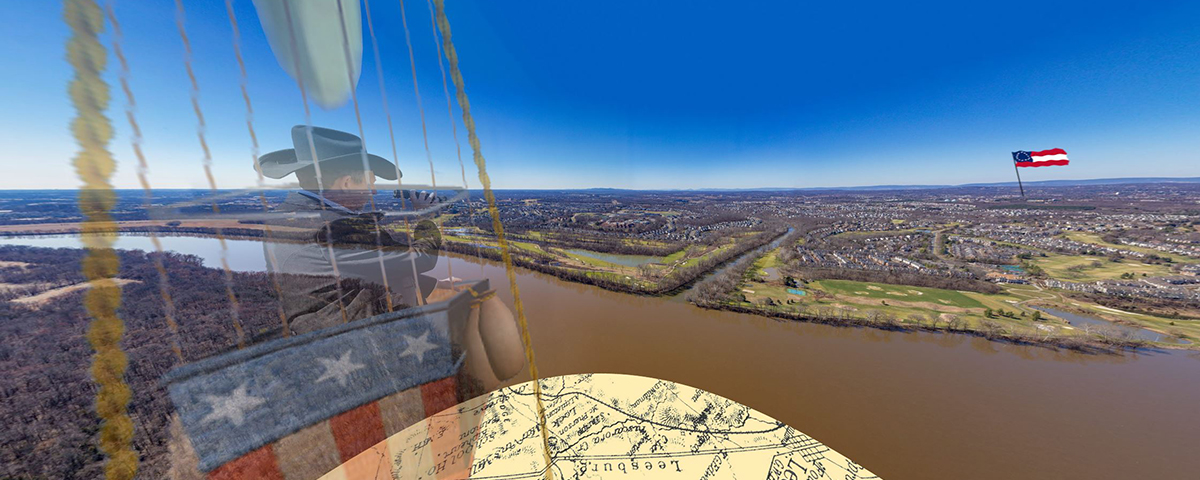As NASA’s chief scientist, James Green studies outer space, but in his downtime he studies the distant-in-time realm of Thaddeus Lowe’s Union Army Balloon Corps. Green became intrigued with the corps after immersing himself in his ancestors’ Civil War service. Along with other Civil War–era balloonist aficionados, Green reenacted on February 27, 2018, the launching of a balloon at Edwards Ferry, Md., in the winter 1862-63, roughly across from Ball’s Bluff in Virginia. It is one of several such events the group has re-created to understand better what the balloon corps could—and could not—accomplish. Curt Westergard and his company, Virginia-based Digital Design and Imaging Service, masterminded the balloon launch and aerial photography, while Green and Tom Crouch, senior curator of Aeronautics at the Smithsonian’s National Air and Space Museum, laid the groundwork for the event.

What is your connection to the Civil War?
I was 12 years old when I learned that my great-grandfather, Elvis Dugger, served in the 32nd Illinois Infantry. Later I learned that one ancestor, Jefferson Dugger, knew President Abraham Lincoln well, and he got Jefferson a job in the U.S. Treasury Department for a few years. Dugger was also one of the 116 members of a Kansas unit, called the Frontier Guard, that helped protect Lincoln. They lived in the White House between the time of Fort Sumter in April 1861 and when the first Massachusetts troops arrive in D.C. That’s how I ran across the Balloon Corps.
What got you hooked?
Balloons completely changed the ability to have long-range observations and get some outstanding intelligence. You go up 800 feet in a balloon tethered with three lines and that would enable Thaddeus Lowe and his aeronauts to see about 15 miles. That’s about how far an army can march in a day. They could stay up for hours to days if they needed to.
How were the balloons used?
On the Virginia Peninsula in spring 1862, Lowe would go up at night and count the campfires. How many Confederates can you get around the campfire? About 10. If you see one road is full of campfires and the adjacent road is not, you know where the enemy army is. The amount of intelligence they could get was unbelievable. The death of the balloons was the army’s inability to recognize how important a role they could play in gathering intel, how important it was to keep that intel quiet and secret, and the ability to task the balloons for specific observations. If you’ve ever been up in a balloon, you have everything visible in front of you. What are you going to concentrate on? There are roads, waterways, forts. What is the observation strategy? What happened later on is that when Joseph Hooker came in to lead the Union Army of the Potomac, recognizing the role that the balloons could play, he actually created the first intelligence organization—the first CIA, if you will—and he would have this group analyze info coming from balloons, interviews of slaves, interviews of soldiers, cavalry observations, and then they would be synthesized and brought to his attention so that he could then see the bigger picture.
What were you reenacting at Edwards Ferry?
The Edwards Ferry over the Potomac River was an easy place to communicate over into Virginia. Early on in the war intelligence was being gathered in Washington, D.C., and transmitted over into Virginia by people carrying messages and notes and letters over the ferry. McClellan wanted that stopped. After the failed intelligence gathering that led to the Battle of Ball’s Bluff in October 1861, McClellan wanted intelligence from the high ground across the Potomac in Maryland. He wanted to know how many troops were being massed, if forts were being built, and roads being covered with batteries, all of which was happening. In 1861, the balloons started operating in December, then January, February and into March 1862 by a few days. We wanted to see how far into Leesburg, Va., we could observe. We wanted to be able to see the couple of remaining forts. Fort Evans is still observable. Fort Beauregard has now been urbanized, so it’s a lost property. We wanted to get the lay of the land. The leaves are down, as they were at that time. We can see the roads. We would like to show some of the views and put what we did in the context of the old maps that were created.
If Thaddeus Lowe lived today, would he be an astronaut? Would you have been a balloonist?
We would have profiled him out, because he didn’t always get along with people. NASA matches personnel so they can work as a team. The balloon corps is a dimension of the Civil War that is like NASA in many ways. It’s the high ground—exciting stuff. I wouldn’t hesitate to have been an aeronaut for Lowe.





